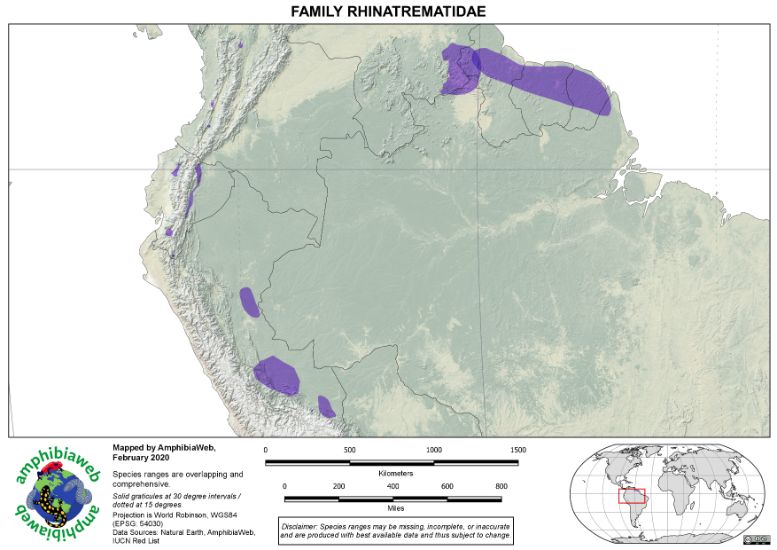Rhinatrematidae |
14 species in 3 genera
Commonly Called Tailed Caecilians, American Tailed Caecilians

Epicrionops sp.
Photo by Moraes et al 2017
(Click for family gallery)The family Rhinatrematidae is comprised of genera of medium-sized caecilians (ranging from 161-328 mm) with true short tails (post-cloacal vertebrae present) as with Ichthyophiidae. Members of this family have primary annuli subdivided by secondary and tertiary annuli. Dermal scales occur in all annuli. The mouth is terminal (not countersunk as in more derived caecilians) and the tentacular opening is adjacent to the eye (considered to be the ancestral condition relative to its more anterior position in other caecilians). Rhinatrematids have partially open temporal regions (zygokrotaphy) on the skull. Zygokrotaphy along with a terminal mouth may suggest they are not highly specialized for burrowing. All caecilians have a dual jaw adducting mechanism, which is unique in vertebrates. In rhinatrematids, the muscle is made up of one bundle (all other caecilian clades have two bundles). Rhinatrematids have a ground color that is gray or grayish to purplish; some exhibit a yellow lateral stripe.
Little is known of their natural history.
Their distribution ranges from northern South America through Brazil, Colombia, Ecuador, Peru, Surinam, Guyana, French Guiana, and Venezuela. Like most caecilians, these are found in tropical forests with dense forest litter and rotting vegetation. The presence of larvae indicates that they are egg layers.
Written by AmphibiaWebNotable Family Characteristics
- Fossorial, may be Terrestrial
- Found in the leaf litter and vegetation of tropical forests
- Egg layers with free-living larvae
- Morphological features include: 1) primary annuli present subdivided by secondary and tertiary annuli, with dermal scales in all annuli; 2) mouth is terminal (not countersunk as in more derived caecilians); 3) tentacular opening adjacent to the eye; 4) skull has open temporal regions (zygokrotaphy); 5) dual jaw adducting muscle is made up of a single bundle; 6) caudal vertebrae and tail with downward projecting arches (haemal arches)
- Distribution limited to South America

Cartography Credit: Zoe Yoo, UC Berkeley
Range maps sources: AmphibiaWeb, UC Berkeley, and IUCN RedListRelevant Reference
Moraes LJCL, Almeida AP, Fraga R, Rojas RR, Pirani RM, Silva AAA, de Carvalho VT, Gordo M, Werneck FP (2017) Integrative overview of the herpetofauna from Serra da Mocidade, a granitic mountain range in Northern Brazil. ZooKeys 715: 103-159. https://doi.org/10.3897/zookeys.715.20288
Pough, F. H., R. M. Andrews, M. L. Crump, A. H. Savitzky, K. D. Wells, and M. C. Brandley. 2015. Herpetology. Fourth Edition. Massachusetts: Sinauer.
Vitt, L. J., and J. P. Caldwell. 2013. Herpetology. An Introductory Biology of Amphibians and Reptiles. Fourth Edition. Amsterdam: Elsevier.
Genus Amazops (1 species)
Amazops amazops account no photos no sound/video
Genus Epicrionops (7 species)
Epicrionops bicolor account no photos no sound/video Epicrionops columbianus no account no photos no sound/video Epicrionops lativittatus no account no photos no sound/video Epicrionops marmoratus account no photos no sound/video Epicrionops parkeri no account no photos no sound/video Epicrionops peruvianus no account no photos no sound/video Epicrionops petersi no account no photos no sound/video
Genus Rhinatrema (6 species)
Rhinatrema bivittatum account no photos no sound/video Rhinatrema gilbertogili no account no photos no sound/video Rhinatrema nigrum no account no photos no sound/video Rhinatrema ron account no photos no sound/video Rhinatrema shiv account no photos no sound/video Rhinatrema uaiuai no account no photos no sound/video
Citation: AmphibiaWeb: Information on amphibian biology and conservation. [web application]. Berkeley, California: AmphibiaWeb. Available: https://amphibiaweb.org/. (Accessed:
AmphibiaWeb's policy on data use.
